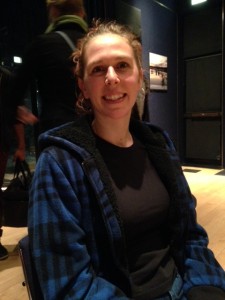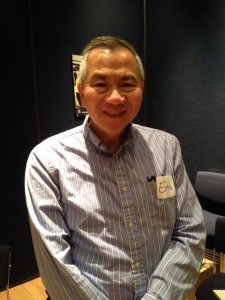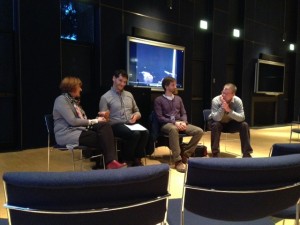UMS Night School: Bodies in Motion – Session 6 Recap
Editor’s note: This post is a part of a series of by U-M student Sarah Squillante, who’s covering our free UMS Night School: Bodies in Motion series. Learn along side with them.
“I used to dance when I was a little girl – I have very fond memories of it,” said one UMS Night School attendee. Eddie King decided to come upon a friend’s suggestion, adding that he’d “been to a bunch of performances before and had never heard this stuff.”
It’s clear that everyone is inspired to come to Night School for difference reasons, but all have one thing in common: a curiosity about body movement.


Newcomers Marly Spieser-Schneider and Eddie King share their first impressions on Night School.
On a sunny Monday night, the class was first split up into small discussion groups to tackle a few questions regarding a recent experimental performance created and performed by Jennifer Monson and DD Dorvillier. They watched a short clip from a past performance of RMW (a)/RW and brought up questions regarding intimacy, the impact of lighting, design, and music choices, audience-performer interaction, social commentary, and the strength of the dancers.
UMS director of education and community engagement Jim Leija, who served as substitute teacher in host Clare Croft’s absence, reminded attendees that it was perfectly acceptable to exit the theater and not “get it” – especially in an experimental piece like this one – even if one is a frequent dance performance patron.
Night School attendees were again treated to a panel of an array of experts – this time in the field of music. Melody Racine, U-M Associate Dean for Academic Affairs and Associate Professor of Voice, Joseph Gramley, U-M Assistant Professor of Music and Co-Coordinator of Percussion, and Conductor Yaniv Segal spoke about the movement of the body in orchestral, percussion, and vocal performances in an effort to prepare attendees for the Israel Philharmonic Orchestra on March 15.

Melody Racine, Jim Leija, Yaniv Segal, and Joseph Gramley discuss body movement in music performance.
Segal began the discussion with a movement exercise intended to convey what exactly a conductor does. The discussion that followed examined the physicality of playing an instrument (and vocal performance), which included the importance of body movement and the necessity of “breath.”
Music performance doesn’t typically get people talking about movement, but attendees were enthusiastic to chat about these genres through the bodies in motion lens. “There was a lot said by the panel that I could identify with as a dancer,” said Marly Spieser – Schneider, a former U-M dance student who was new to Night School. “There’s usually a language barrier between dancers and musicians, and it was nice to hear things that really resonated with me.”
Attendee Geoff Smereck added that Night School has equipped him with a movement vocabulary that transcends performances: “One cross-cutting concept that I’m applying to all performances is harmony,” he said.
For Marly, Night School was a great experience because the discussion didn’t get stuck on one topic for too long. “The first topic could have taken an hour, but it’s good to discuss something and then move on, since some people won’t be able to connect to a particular topic.”
Night School continues at the same time and place on Monday, March 17 at 7 PM in the U-M Alumni Center. The next session – “Dance on Camera” – will focus on creating dance for film. The dance-curious are also invited to check out Gillam dance’s performance of “Sit, Kneel, Stand” at the Berman Center for the Performing Arts on March 12.
Session Resources
- UMS Bodies in Motion Session 6 – Key Theme, Players, and Definitions [Word Document assembled by Marcus White, MFA Candidate – Dance, University of Michigan]
Interested in even more dance engagement? Pick up an adventure card to learn all about the dance activities we’re offering this year and for a chance to win a backstage meet and greet.
Share questions, comments, or suggestions in the comments below.





